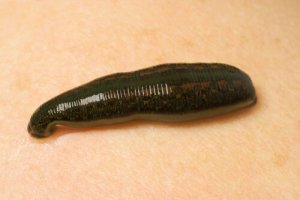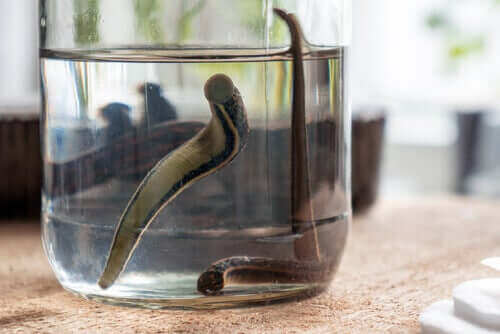Hirudo Medicinalis: The Medicinal Leech

Hirudo medicinalis is a leech, and therefore an invertebrate in the Annelida phylum and the Hirudinae family. This specific kind of leech has been used for medical purposes for many centuries, which is where it got its more common name: the medicinal leech.
The history of the medicinal leech
There are written records of people using leeches for medical purposes all the way back to Ancient Egypt, Greece, Rome, and Mesopotamia. During the Middle Ages, leeches were actually relatively common for treating a wide variety of conditions.
This was because people thought the body was composed of four humors: blood, yellow bile, black bile, and phlegm. The theory was that any changes to the balance of the four humors led to medical problems.
This meant that sucking out a bit of the most important humor (blood) was key to re-establishing that balance. They had two major ways of doing that: bloodletting and medicinal leech therapy.
Anatomy
The medicinal leech is a hermaphrodite, segmented worm in the Annelida phylum and the Hirudinae family. Of all the 600 different varieties of leech, this is the most valuable in the medical field.
Fully grown adults can reach nearly 8 inches after they’ve eaten. If they haven’t eaten, they can be about a third of that length. They have two suckers, one in the back and one in the front of their body.
The “front” sucker is like its mouth. It’s small, mobile, and has three jaws that help it suck out blood. Each jaw has anywhere from 60-100 teeth, which create a kind of “Y” shape within the jaw. The “back” sucker is mostly just to help it latch on, and stay latched.
Medicinal leech saliva
Medicinal leeches have salivary glands that secrete around 60 different proteins. They all have different medical properties. Here are some of the ones most worth mentioning:
- Anticoagulants: mainly hirudin, which prevents thrombin from coagulating
- Vasodilators: these substances are similar to histamine, and they expand your arteries, which makes more blood flow
- Anesthetics: leech bites are painless, and many people believe it’s because their saliva has anesthetic substances
- Anti-inflammatories
- Antimicrobials
- Proteinase inhibitors

Medicinal leech usage
Medical treatments with leeches also go by the name “leech therapy.” People store the leeches in glass jars covered with a damp cloth, in a cool place. You can’t put a leech in an airtight jar.
When it comes to taking them out, you use tweezers and a smaller glass jar to make sure they don’t get away, and latch onto the right place. The skin you want them to latch onto needs to be clean, too. If the leech isn’t biting, you can put some sugar water on the skin.
Once you’ve taken a leech off (it’ll detach once it has gotten its fill), the wound will still stay open for a few hours. So, you’ll need to have a cotton ball on hand to apply to the wound. Take it off the next day and use a new one the next day, after you’ve checked to see how the wound looks.
The swollen area should look much better after just a few days. If the leech hasn’t detached even after it’s full, you should put some saltwater on the area. That makes it easier to get off, and you won’t run the risk of infection because you won’t have to yank it off.
Medicinal leeches are one-use only. Once you have used one, you have to seal it away and burn it. There are no known cases of infections from their bite.

Conditions people use leech therapy to treat
Here are some of the main conditions people have used leech therapy to treat:
- Joint inflammation
- Plastic surgery recovery
- Migraines
- Thrombosed hemorrhoids
- Chronic eczema
There’s an old story about pilgrims on the Camino de Santiago (in Spain), and how they would take breaks by ponds and rivers. They would use those spots as a place to freshen up and revitalize themselves after a long journey. They also had some unexpected help. The leeches in the water relieved any swelling and prevented blood clots.
Leech therapy: benefits and warnings
Leech therapy doesn’t have side effects or other known negative consequences. It’s also safe and completely harmless. But there are some cases where you wouldn’t want to do leech therapy.
One of the big warnings is not to perform it on anyone with a weak immune system or arterial insufficiency. There’s also a risk of infection from the bacteria Aeromonas hydrophilia. This bacteria has a symbiotic relationship with the medicinal leech. The bacteria gets to live in its intestines, and it provides an enzyme that helps the leech digest blood.
One last thing we should mention: leech therapy should only ever be a last resort, when nothing else has worked. It’s also essential to give a patient all the information, and get their permission. You also need to mention that it’s a procedure that should only ever happen within a hospital.
Hirudo medicinalis is a leech, and therefore an invertebrate in the Annelida phylum and the Hirudinae family. This specific kind of leech has been used for medical purposes for many centuries, which is where it got its more common name: the medicinal leech.
The history of the medicinal leech
There are written records of people using leeches for medical purposes all the way back to Ancient Egypt, Greece, Rome, and Mesopotamia. During the Middle Ages, leeches were actually relatively common for treating a wide variety of conditions.
This was because people thought the body was composed of four humors: blood, yellow bile, black bile, and phlegm. The theory was that any changes to the balance of the four humors led to medical problems.
This meant that sucking out a bit of the most important humor (blood) was key to re-establishing that balance. They had two major ways of doing that: bloodletting and medicinal leech therapy.
Anatomy
The medicinal leech is a hermaphrodite, segmented worm in the Annelida phylum and the Hirudinae family. Of all the 600 different varieties of leech, this is the most valuable in the medical field.
Fully grown adults can reach nearly 8 inches after they’ve eaten. If they haven’t eaten, they can be about a third of that length. They have two suckers, one in the back and one in the front of their body.
The “front” sucker is like its mouth. It’s small, mobile, and has three jaws that help it suck out blood. Each jaw has anywhere from 60-100 teeth, which create a kind of “Y” shape within the jaw. The “back” sucker is mostly just to help it latch on, and stay latched.
Medicinal leech saliva
Medicinal leeches have salivary glands that secrete around 60 different proteins. They all have different medical properties. Here are some of the ones most worth mentioning:
- Anticoagulants: mainly hirudin, which prevents thrombin from coagulating
- Vasodilators: these substances are similar to histamine, and they expand your arteries, which makes more blood flow
- Anesthetics: leech bites are painless, and many people believe it’s because their saliva has anesthetic substances
- Anti-inflammatories
- Antimicrobials
- Proteinase inhibitors

Medicinal leech usage
Medical treatments with leeches also go by the name “leech therapy.” People store the leeches in glass jars covered with a damp cloth, in a cool place. You can’t put a leech in an airtight jar.
When it comes to taking them out, you use tweezers and a smaller glass jar to make sure they don’t get away, and latch onto the right place. The skin you want them to latch onto needs to be clean, too. If the leech isn’t biting, you can put some sugar water on the skin.
Once you’ve taken a leech off (it’ll detach once it has gotten its fill), the wound will still stay open for a few hours. So, you’ll need to have a cotton ball on hand to apply to the wound. Take it off the next day and use a new one the next day, after you’ve checked to see how the wound looks.
The swollen area should look much better after just a few days. If the leech hasn’t detached even after it’s full, you should put some saltwater on the area. That makes it easier to get off, and you won’t run the risk of infection because you won’t have to yank it off.
Medicinal leeches are one-use only. Once you have used one, you have to seal it away and burn it. There are no known cases of infections from their bite.

Conditions people use leech therapy to treat
Here are some of the main conditions people have used leech therapy to treat:
- Joint inflammation
- Plastic surgery recovery
- Migraines
- Thrombosed hemorrhoids
- Chronic eczema
There’s an old story about pilgrims on the Camino de Santiago (in Spain), and how they would take breaks by ponds and rivers. They would use those spots as a place to freshen up and revitalize themselves after a long journey. They also had some unexpected help. The leeches in the water relieved any swelling and prevented blood clots.
Leech therapy: benefits and warnings
Leech therapy doesn’t have side effects or other known negative consequences. It’s also safe and completely harmless. But there are some cases where you wouldn’t want to do leech therapy.
One of the big warnings is not to perform it on anyone with a weak immune system or arterial insufficiency. There’s also a risk of infection from the bacteria Aeromonas hydrophilia. This bacteria has a symbiotic relationship with the medicinal leech. The bacteria gets to live in its intestines, and it provides an enzyme that helps the leech digest blood.
One last thing we should mention: leech therapy should only ever be a last resort, when nothing else has worked. It’s also essential to give a patient all the information, and get their permission. You also need to mention that it’s a procedure that should only ever happen within a hospital.
All cited sources were thoroughly reviewed by our team to ensure their quality, reliability, currency, and validity. The bibliography of this article was considered reliable and of academic or scientific accuracy.
-
Cornejo-Esquerra A, Talleri-de-Andrea G, Blanco-Favela J de J, Ramos-Mora A, Villarán-Muñoz B. Sanguijuela Hirudo medicinalis: una alternativa terapéutica disponible en México. Revista Médica del Instituto Mexicano del Seguro Social [Internet]. 2009 [citado 17 de junio de 2019];47(3). Disponible en: http://www.redalyc.org/resumen.oa?id=457745514018
-
Enrique Angulo Sánchez. Efectividad de la Terapia con sanguijuelas. Revisión bibliográfica. Universidad de Salamanca, Campus de Ávila. 3 de octubre de 2016;Escuela de Enfermería de Ávila, centro adscrito a la Universidad de Salamanca:31. Disponible en: http://www.cabinadehirudoterapia.com/informe.pdf
-
Manrique Sáez MP, Ortega Larrea S, Yanguas Jiménez P. La sanguijuela, un gusano en la historia de la salud. Index de Enfermería. diciembre de 2008;17(4):290-4. Disponible en: http://scielo.isciii.es/scielo.php?script=sci_arttext&pid=S1132-12962008000400016
This text is provided for informational purposes only and does not replace consultation with a professional. If in doubt, consult your specialist.








